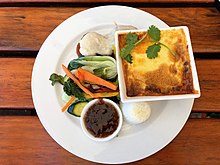South African cuisine
The South African cuisine has its spread in the Republic of South Africa .
General
The South African cuisine is not a uniform structure and is interpreted and claimed for itself by each of the various population groups in South Africa. Every province in South Africa has peculiarities and focuses. In KwaZulu-Natal z. B. Indian influences dominate due to the high number of Indians , in the Western Cape Malay influences are pronounced and in Gauteng a strong influence from the Boers . The influence of Indonesian cuisine is also clearly noticeable . Black African and Khoisan influences are hardly present in Cape cuisine.
In the 17th century, the first Europeans established a base on the Cape of Good Hope. Jan van Riebeeck founded Cape Town in 1652 . With the immigration of German, French and Dutch settlers , European influences came to the Cape Colony . The Dutch authorities brought numerous slaves, soldiers and artisans with them from their Asian colonies in Indonesia , India and Malaysia . From the beginning of the 19th century, the English influence on South African cuisine became dominant.
Food and groceries
flesh
Meat is one of the main ingredients in Cape cuisine. Lamb is the most popular, followed by beef . Pork, on the other hand, is not very common. Is very popular game .
The meat of the springbok , blessbok and oryx , kudu , eland and warthog is particularly popular in rural areas, and increasingly also in urban areas .
In general, it can be said that all meat is processed and consumed. Even animal species such as B. Porcupines are always a welcome change.
A typical South African specialty is dried meat - biltong .
fish
Amazingly, fish plays a minor role among the ingredients. The Atlantic along the west coast is one of the most biodiverse and fertile waters in the world.
On the coasts (especially the west coast and the Cape region) and in large cities such as Johannesburg , Durban or Cape Town , fish is eaten in considerable quantities. The rapid increase in tourism and improved infrastructure have made fish more popular in recent years.
Only members of the indigenous population, traditionally strongly represented in fishing, eat fish regularly, also due to religious commandments.
poultry
Poultry , mainly chicken , is processed and prepared in large quantities. The meat of the African ostrich is mainly for export . This healthy and low-fat meat is becoming increasingly popular. House guinea fowl is extremely tasty and happy to be prepared .
vegetables
Vegetables are rarely served as a side dish, as is common in Europe, but are usually part of various dishes.
Popular are pumpkin (u. A. Gem squash and butternut ), onion , carrot , beans , corn (mainly to Mieliepap processed). Potatoes and green salad are rarely served. Worth mentioning is the Waterblommetjie ( Aponogeton distachyos ), in English "African water ear", a water plant that is harvested in the winter months.
Desserts
Sweets in South Africa are not very independent. Hearty, heavy and heavily sweetened dishes such as trifle , malva pudding , Koeksisters or Melktert dominate here . Although all types of fruit are grown in enormous quantities, they are mainly used for export.
Spices
Herbs and spices are used liberally. Coriander , cardamom , cloves , cinnamon , ginger and chilli are particularly popular .
beverages
In South Africa, alcoholic and non-alcoholic drinks are served with meals . Wine plays a special role . White wine from local cultivation is particularly popular . Rooibos tea is also popular. Beer is also popular .
Known beers:
- Umqombothi
- Castle warehouse
- Castle Lite
- Windhoek warehouse
- Hansa Pilsener
- Amstel
- Carling Black Label
Typical dishes

Different types of biltong and droëwors
|
Other dishes that are very often eaten but come from abroad:
- Pickled Fish
- Roast Leg of Lamb
- Masala Fish
- Sambals
- Mince curry
- Scones
- Chicken Beriyani
- Shortbread
- samosas
- Malva pudding
- Chutney
- Crayfish curry

